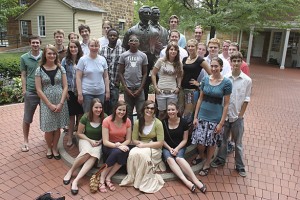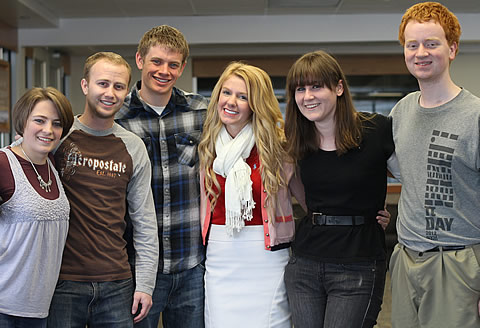Why does there appear to be a vast number of 20-somethings who are leaving religious institutions of all faiths? Christian author Naomi Schaefer Riley addresses this important question in her new book Got Religion? She answers the question from an optimistic viewpoint as she discusses ways some religious communities are actively engaged in helping to make sure that number of 20-somethings who are exiting remains at a minimum.
How Religious Communities Can Help Perfect the Saints
Jana Riess in her Religion News Service (RNS) article dated 18 July 2014 points out that Riley cites three important key elements that the most successful religious communities incorporate in order to help retain their number of 20-somethings:
- They provide stability during a period of transience. .
- They give them important things to do to make the religious community work.
- They help them form spiritual habits to last a lifetime.
An entire chapter in Riley’s book is devoted to discussing how Mormon singles wards are providing crucial help in all three of these areas. The following guidelines as set forth in section 16 of Handbook 2: Administering the Church (instructions for leaders of The Church of Jesus Christ of Latter-day Saints) which is titled “Single Members” supports what she says in the chapter:
Men and women who have not married or who are divorced or widowed make up a significant portion of Church membership. Priesthood and auxiliary leaders reach out to these members and include them in the work of the Church. Worthy single members should be given opportunities to hold leadership and teaching positions, including positions in Elders Quorum presidencies, High Priests Group leaderships, and auxiliary presidencies.
Leaders support single members by helping them draw near to the Lord, strengthen their testimonies, and take responsibility for their own spiritual, social, and temporal well-being.
In ministering to single members, leaders seek to strengthen family life, not compete with it or detract from it. They teach and testify of the importance of marriage and parenthood. Even when young single adults are not living with their parents, Church leaders encourage them to honor and nourish their relationships with their parents. Leaders also support single parents in their efforts to teach and nurture their children.
Important Questions That Warrant an Answer
In a follow-up conversation with author Naomi Schaefer Riley, Riess was able to ask some pointed questions regarding the mass exodus that religious institutions of many faiths are currently experiencing. She specifically focused on the chapter in Riley’s book about Mormon singles wards and asked questions about Mormon dating and marriage, leadership opportunities, and the pros and cons of the singles ward system. What follows are a few of those questions and answers.
Question: How has the overall trend toward later marriage affected Mormons in their 20s and 30s?
It looks like the Mormon age of marriage is starting to creep up as well.
During the 1990s, the General Social Survey found an average age of Mormon first marriage of 21.6. In a survey I conducted in 2010 for my book on interfaith marriage, it was up to 23.
This age may not seem high yet, but if the Mormon population follows the trend of the rest of the American population (albeit at a slower pace), it could have a significant effect on rates of religious observance and retention across generational lines. In that survey I found also found the later the age of marriage the more likely people were to marry someone of a different religion.
Question: You make the point that religions that don’t provide leadership opportunities to young adults are doomed. The success stories are religious traditions that are enlisting 20-somethings into service. How does Mormonism fit into that?
As we are living longer, healthier lives, some church members start to get a little territorial, staying in the same volunteer position for years or even decades. Young adults who show up often feel as if their presence is superfluous.
This is one of the things that really impressed me about Young Single Adult wards. The LDS church was willing to say to 20-somethings, “Even though your parents may treat you like children because you’re not married, not done with school, don’t have full-time employment, etc., we, the church, are going to treat you like grownups — putting you in charge of collecting tithes, religious education and a variety of other important functions.”
The church came to what I think is the correct conclusion — if you treat 20-somethings like adults, they will act like adults.
Question: You talk about the poignant transition when YSAs age out, Logan’s Run style, after age 30. What are the pros and cons of such a system?
I think the pros are that these young people are able to take more responsibility and that the services and messages of religious leaders can be more closely tailored to their needs.
I think the cons are that the ward itself has a very transitional feel. People are constantly moving in and out. Whether they age out or get married, it can feel very impermanent. Which is how a lot of 20-somethings feel already. Every time you force a young adult to make a transition, you risk losing him or her and so adding another step to this process can be risky.
Riley also praised the multi-generational experience that Young Single Adults (YSA) get in The Church of Jesus Christ. She notes that such an experience helps to keep them grounded and helps them to realize that the world does not revolve around them and their needs alone. She also notes that this has been a recurring problem with such Christian programs as Campus Crusade. She further commented, “I think the Mormon Church avoids some of the problems that could come with an YSA arrangement because many of the young people are still living close to large extended families. So they get the multi-generational experience outside of church.”



